This is a remastered, improved version on December 23, 2023.
Download
kuina_chan_fusion_20231223.mp3
kuina_chan_fusion_20231223.mp3

The following 12 songs, totaling 40 minutes, are connected without a break (Figure 0-1).
- Sandcastles and Ice Cream [0:00]
- Rotted Clock Tower [3:32]
- The Wind That Carries Spring [7:04]
- Gleaming Frozen World [10:34]
- Children's Territory [13:54]
- Beasts Ride Through the Storm [17:16]
- Wishes of Penguins [20:24]
- The Serpent [24:03]
- Soap Bubble Minuet [27:13]
- Fire Festival at Dusk [30:53]
- Non-Alcoholic Cocktails [34:09]
- Stardust Flood [36:59]
Below is a description of each piece of music.
1Sandcastles and Ice Cream [0:00]
A gentle breeze blowing on a sandy beach in midsummer. Since it is the first song, it is easy to understand and catchy tune.
C major, 4/4 time, sonata form. Exposition, development, and recapitulation, in that order. Elements of "fusion."
1.1Exposition [0:00]
[0:00] The exposition part of this piece consists of an introduction, first theme, transition, and second theme. It begins with a gorgeous introduction (Figure 1-1).

[0:14] The first theme is a light, syncopated phrase that evokes the joy of playing on a sandy beach. Generally, in sonata form, the first theme is played in the main key with a light phrase, and the second theme is played in a modulating, relaxed phrase, drawing a contrast between the two themes (Figure 1-2).

[0:26] Transition section. Here preparations are made to move on to the second theme. It is casually transposed from C major to B major. To impress the audience, the first theme - transitional section is repeated once more (Figure 1-3).

[1:18] This is the second theme, which evokes the image of a vast seaside. The melody is played as if it were singing, over a rhythm punctuated firmly with quarter notes (Figure 1-4).

1.2Development [1:47]
[1:47] The development section of a sonata form is generally played freely, combining the first theme, second theme, and so on. In this piece, the first half of the development section is a syncopated rhythm like the first theme, and the second half is an improvised phrase using a quarter-note rhythm like the second theme (Figure 1-5).

1.3Recapitulation [2:45]
[2:45] In the recapitulation section, the exposition is reproduced. However, while the second theme is played in a different key from the first theme in the exposition, they are played in the same key in the recapitulation, giving the impression that the tension has been resolved.
2Rotted Clock Tower [3:32]
Even when the hands have stopped, the time continues to tick away.
D minor, 5/4 time, sonata form. Exposition, development, and recapitulation, in that order. Elements of "classical."
2.1Exposition [3:32]
[3:38] It begins with a tense introduction. The five beats are inspired by the second hand of a clock (Figure 2-1).

[3:41] This is the first theme. The extensive use of notes that are not in the original key scale creates an atmosphere of uneasiness (Figure 2-2).

[3:54] Transition. A phrase biased toward high notes changes the atmosphere, creating an effect that highlights the second theme (Figure 2-3).

[4:09] The second theme. The melody is emotional and somber, without the dissonance that had been present up to this point (Figure 2-4).

2.2Development [4:49]
[4:49] The tense phrases, mainly grounded in the first theme, are developed in an unobtrusive manner.
2.3Recapitulation [5:47]
[5:47] The exposition is recapitulated. The second theme is played in the same key as the first and ends in a sad mood.
3The Wind That Carries Spring [7:04]
Spring has arrived.
E major, 4/4 time, three-part form. Elements of "bossa nova."
3.1Part A [7:04]
[7:04] It is a light and peaceful introduction (Figure 3-1).

[7:13] It progresses in a fast, light rhythm. It is an image of the coming of spring (Figure 3-2).

3.2Part B [8:20]
[8:20] The melody is freely modulated and sung (Figure 3-3).

[8:41] The song repeatedly modulates and builds up with a sense of sadness (Figure 3-4).
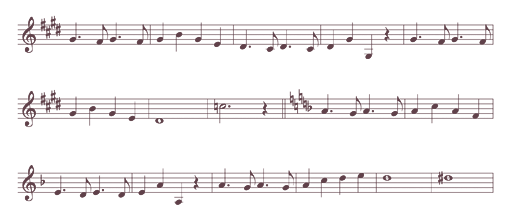
[9:00] After returning to the original key, the melody develops even more freely.
3.3Part A [9:38]
[9:38] Part A is played again. In contrast to the sonata form, the three-part form may seem small, simple, and mild in its excitement.
4Gleaming Frozen World [10:34]
A silvery, frozen world, illuminated by moonlight.
F minor, 4/4 time, free form. Elements of "trance."
[10:34] It begins with a phrase that is important throughout the piece. From then on, this phrase is used frequently (Figure 4-1).

[10:44] A minimalist progression continues, with characteristic riffs repeated (Figure 4-2).

[11:11] The accompaniment stops for a moment and the opening phrase is played. Then the minimalist progression is repeated again (Figure 4-3).

[11:51] Middle section. A new theme is used, and a free and beautiful melody develops in contrast to the simple progression of the previous pieces (Figure 4-4).

[12:31] Eventually, the phrases from the beginning are interwoven and the excitement builds (Figure 4-5).

[13:11] It then returns to a minimalist progression and closes with a lingering finish.
5Children's Territory [13:54]
Selfish and free-spirited, yet endearing.
G major, 4/4 time, sonata form. Exposition, development, and recapitulation, in that order. Elements of "rock 'n' roll."
5.1Exposition [13:54]
[13:54] Characteristic introduction (Figure 5-1).

[14:07] First theme. The whole-tone descending chords and throw-away melody create a free-spirited image (Figure 5-2).

[14:32] Second theme. It is a phrase that expresses courage and daring without fear, continuing to ascend and then rushing down at once (Figure 5-3).
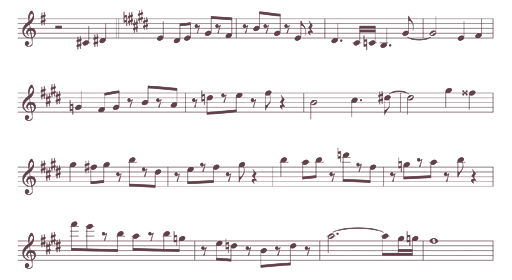
5.2Development [15:03]
[15:03] The development section begins with a phrase that combines the first and second themes. Compared to the energetic exposition section, the development section is a bit more sombre (Figure 5-4).

5.3Recapitulation [15:36]
[15:36] The exposition is recapitulated. The next intense piece awaits, so the connection between the pieces is long and rushed.
6Beasts Ride Through the Storm [17:16]
They are unafraid and never look back.
A minor, 4/4 time, sonata form. Exposition, development, and recapitulation, in that order. Elements of "melodic speed metal."
6.1Exposition [17:16]
[17:17] It is the first theme of a long phrase that is solemnly positive. Raised a semitone higher, the theme repeats itself with a wistful iron harp sound (Figure 6-1).
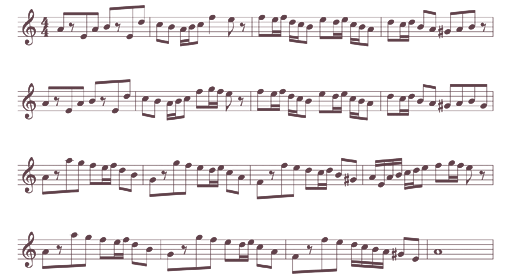
[18:07] The majestic second theme. While the first theme was a detailed phrase with many sixteenth notes, this is a leisurely melody composed of eighth and quarter notes (Figure 6-2).
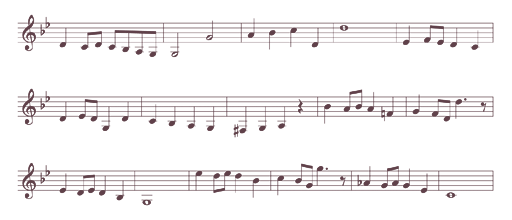
6.2Development [18:35]
[18:35] Free development section. Every few bars the chord rises a semitone, creating a tense atmosphere.
6.3Recapitulation [19:22]
[19:22] This is a recapitulation of the exposition. It ends while slowing down the tempo.
7Wishes of Penguins [20:24]
This is a piece of music in odd time, inspired by the penguins' unsteady steps.
B major, flat time, free form. Elements of "odd time."
For the sake of convenience, the order of composition here is A, B, C, B, and A.
[20:30] Part A. The melody repeats "8 beats, 7 beats, 6 beats, 7 beats." The repetition of ascending and descending melodies by woodwinds behind the melody is characteristic (Figure 7-1).
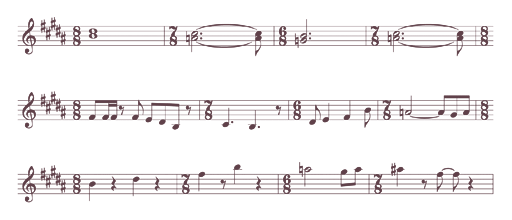
[21:05] End of part A. A somewhat avant-garde chord progression (Figure 7-2).

[21:17] Part B. A melody as vast as the sky is combined with a rhythm in odd time signatures (Figure 7-3).

[21:40] Part C is a free phrase played in 7/8 time, depicting the wishes of the penguins.
[23:02] After the C part, the B and A parts are played retroactively.
8The Serpent [24:03]
It is atonal music, that is, it is not in any key, such as C major or D minor.
Atonal, 4/4 time, sonata form. Exposition, development, and recapitulation, in that order. Elements of "atonal."
8.1Exposition [24:03]
[24:03] It is a sudden prelude (Figure 8-1).

[24:17] The first theme is harmonious throughout in that each note is not harmonious. It is played twice with changing details (Figure 8-2).
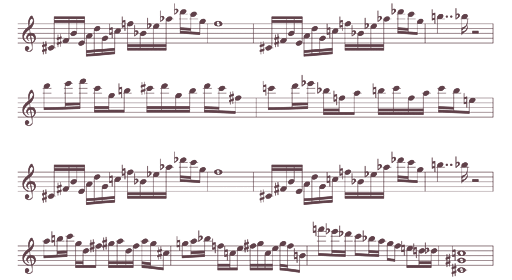
[25:14] The dissonant yet singing second subject. A slight sweetness spreads pleasantly (Figure 8-3).
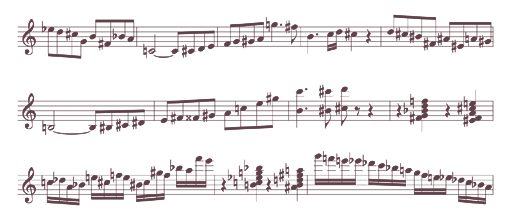
8.2Development [25:31]
[25:31] A free development section played over an eighth-note rhythm. It concludes with the only harmonious sound.
8.3Recapitulation [26:10]
[26:10] Recapitulation of the exposition. The transition between the first and second themes is removed and the piece comes to an end.
9Soap Bubble Minuet [27:13]
The soap bubbles were fluffy and seemed to be dancing a minuet.
E-flat major, 3/4 time, sonata form. Exposition, development, and recapitulation, in that order. Elements of "minuet."
9.1Exposition [27:13]
[27:13] First theme. The melody by the recorder flows naively over the slow three-beat accompaniment (Figure 9-1).

[27:54] An emotional transition section that seems to appeal to something (Figure 9-2).

[28:11] The spontaneous second theme. It is played twice, but the chords are different when the melody reaches its peak, giving the first time a wistful impression and the second time a warmer one (Figure 9-3).

9.2Development [28:43]
[28:43] It is a development section of peaceful and fantastic phrases. In contrast to the bright exposition, it is played in a shady atmosphere without being too exciting (Figure 9-4).

9.3Recapitulation [29:48]
[29:48] This is a reproduction of the exposition. Once again, a bright, sunny scene is depicted.
10Fire Festival at Dusk [30:53]
The people begin their rituals around the soaring flames.
F-sharp minor, 11/16 time, sonata form. Exposition, development, and recapitulation, in that order. Elements of "folk dance."
10.1Exposition [30:53]
[31:00] First theme. It is a passionate and dramatic rhythm and melody. It is played twice (Figure 10-1).
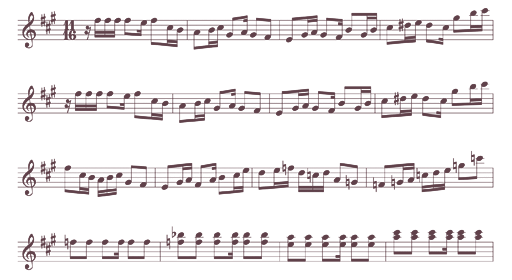
[31:43] Second theme. Whereas the first theme was in a minor key, the second theme is delightfully rendered in a major key (Figure 10-2).

10.2Development [32:05]
[32:05] Development section. After a short rhythmic pause, a long phrase is played in one breath, beginning with the same cue as the first theme.
10.3Recapitulation [33:04]
[33:04] Recapitulation of the exposition. The cheerful major key of the second theme is used to connect to the next piece.
11Non-Alcoholic Cocktails [34:09]
Shake equal parts of lemon, orange, and pineapple juices to complete the drink.
A-flat major, 4/4 time, rondo form. A, B, A, C, A, B, A. Elements of "swing jazz."
11.1Part A [34:09]
[34:09] The phrase consists only of triplets, with a swinging feel. The melody is slightly loose and de-emphasized (Figure 11-1).
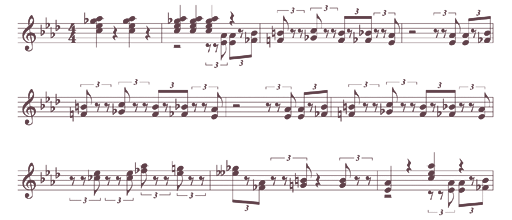
11.2Part B [34:32]
[34:32] Skipping rhythms and somewhat snazzy-sounding phrases (Figure 11-2).

11.3Part A [34:43]
[34:43] Part A is played again.
11.4Part C [34:54]
[34:54] Only the melody is one triplet note faster, a phrase that seems to be in the foreground. The sweet-sounding melody is played twice, using a lot of 7th and 9th degree chords (Figure 11-3).
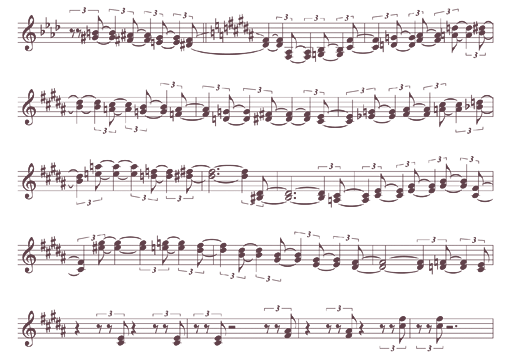
[35:37] In the second half, improvisational phrases sound freely.
11.5Part A [36:01]
[36:01] Part A is played again.
11.6Part B [36:24]
[36:24] Part B is played again.
11.7Part A [36:35]
[36:35] Part A is played again.
12Stardust Flood [36:59]
I looked up and saw a flood of stardust all over the night sky.
B-flat major, 4/4 time, free form. Elements of "happy hardcore."
[37:04] A sparkling, sad yet bright, catchy melody is played twice, modulating to a light rhythm (Figure 12-1).
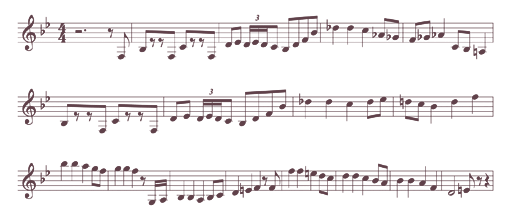
[37:46] In the middle section, a minimalist, easy-to-understand phrase is repeated over and over (Figure 12-2).

[38:49] Then the first catchy melody is reproduced, followed by a minimalist phrase for the final spurt.
[39:53] It ends with a flourish (Figure 12-3).



